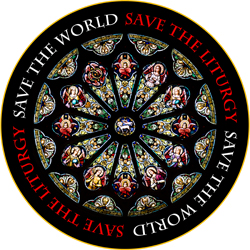I am going to 'blog this in its entirety, as the archives at the Diocese of Paterson, NJ web page don't seem to be working properly.
The idea that this guy is taking over from Bishop Trautman is beyond comforting. And I know, from personal experience, the hard row Serratelli has to hoe in that diocese. (Some of the worst, most flagrant, unequivocal liturgical abuses I have ever seen, ingrained in the praxis of the people. I always hated that aspect of visiting C, or J & A... it was painful to know that some of them are "fallen away" but it was easy to see at least some of the reasons.)
...................
One of the major divisions between Catholics and Protestants is the Eucharist. How do we understand what Jesus did at the Last Supper? What was his intention? Did he gift the Church with a simple memory of his suffering and death in giving the bread and wine as symbols of the Paschal Mystery? Did he actually give his Body and Blood to the disciples around the table in the Upper Room? Does he give his Body and Blood to believers around the altar today?
From apostolic times, all the followers of Jesus have believed in the Real Presence. That is until the birth of Protestantism in the 16th century! Before the time of Luther, however, there were a few dissident voices who denied the faith of the Church in the Real Presence.
Very early on, St. Ignatius of Antioch (110 A.D.) tells us that the Gnostics refused to believe in the Real Presence. He says, “They abstain from the Eucharist and from prayer because they do not confess that the Eucharist is the flesh of our Savior Jesus Christ, flesh which suffered for our sins and which that the Father, in his goodness, raised up again” (Letter to the Smyrnaeans 6:2-7:1). At least they had the personal integrity not to approach the Eucharist because they did not accept what the Church taught.
When the early Church Fathers read 1 Cor 10:16–17; Jn 6:32–71; and the accounts of the Last Supper (Mt 26:26-28: Mk 14:22-23: Lk 22:19-20; and 1 Cor 11:23-25), they interpreted these passages literally. J. Kelly, the renowned Protestant historian of the early Church, succinctly summarizes their teaching on the Real Presence when he writes, "[Their] Eucharistic teaching, it should be understood at the outset, was in general unquestioningly realistic, i.e., the consecrated bread and wine were taken to be, and were treated and designated as, the Savior’s body and blood" (Early Christian Doctrines, 440).
The first Christian of any prominence to deny the Real Presence was Berengar of Tours. He lived in the 11th century! He was a young priest in charge of a theological school in Tours with many distinguished students who later became bishops and archbishops. Berengar denied the belief that Jesus is really and truly present in the Eucharist under the appearances of bread and wine. He called such belief "the opinion of the mob." And he taught that the Eucharist is simply a symbol of Christ's presence among us.
Berengar’s teaching actually helped the Church. In response to his denial of an essential element of the deposit of faith, the Church began to teach more extensively about the Real Presence. Interestingly enough, in the pursuing discussion of his teaching among theologians and bishops, he retracted what he said at least five times.
Finally, at the Fourth Lateran Council in 1215, the Church formally defined that "by divine power bread and wine are transubstantiated into the Body and Blood" (canon 1). The doctrine of the Real Presence is simply, yet profoundly, this: the Eucharist is the Body and Blood, Soul and Divinity of Jesus Christ under the appearances of bread and wine.
Under the appearances of bread and wine. This means it is not bread. It is not wine. It is the Body and Blood of Christ. What a great disservice to the faith of the Church when it is said at communion time that the wine will be distributed in such and such a way or the bread will be given out in a certain fashion. Why not call Holy Communion what it truly is: the Body of Christ and the Blood of Christ?
The fourth gospel conspicuously lacks the narrative of the institution of the Eucharist at the Last Supper. But John is deeply Eucharistic in his gospel. The day after Jesus performed the miracle of the multiplication of the loaves and the fish, John records Jesus teaching in the synagogue at Capernaum. Jesus openly declares that he had come to give us his flesh and his blood as true food and true drink (cf. Jn 6:26-58). To many, his teaching was strange and difficult to accept. Many who had been following him complained, “This is hard saying! Who can accept it?” (Jn 6:60). Some of his disciples stopped following him because of his teaching on the Eucharist. Jesus let them go.
“Then, as now, the Eucharist remains a "sign of contradiction" and can only be so because a God who makes himself flesh and sacrifices himself for the life of the world throws human wisdom into crisis” (Pope Benedict XVI, Homily at St. John Lateran, June 7, 2007). True following of Jesus includes acceptance of the sacred gift of the Eucharist. And proper faith in the Eucharist as the Real Presence opens the way to understand all the dimensions of this mystery and the sacredness of our entire life.
Subscribe to:
Post Comments (Atom)




No comments:
Post a Comment